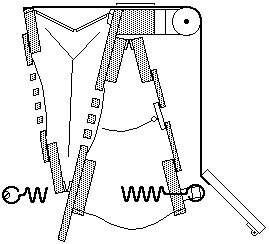
Chapter 4.1 - Wind Supply, Introduction
--------------------
SPECIAL NOTE
--------------------
When the organ was offered for sale, it was clearly described as requiring lots of TLC. When I went to England in the spring of 2000, the owner pointed out all the potential faults, and I was given complete access, inside and out, for me to do my own assessment. I believe that the price more than fairly reflected both its present condition, and its potential for restoration. Furthermore, the seller very kindly gave me many spares from his stock, to replace the components that were missing.
I was advised not to buy that organ; it was missing too much, and needed too much work. But that is exactly what I wanted. I was determined to do a complete, frame-up restoration. In a way, this situation relieves me of the dilemma faced by many Orchestrelle rebuilders; should I try to reuse this pouch, cloth or gasket, or replace it? I said, what the hell, replace everything. I believe that it will come out easier to pump and more reliable than many contemporary restorations, but the responsibility for that rests entirely on me. If it does succeed, then my decision will have been justified; if not, I will end up with some very expensive egg on my face.
--------------------
Here is a cross section of the bellows assembly, somewhat distorted to make it clear.

The foundation is a piece of lumber core plywood extending the entire width of the organ, nearly six feet. Two feeder bellows are surface mounted on the back, and one huge reservoir is on the front, extending widthwise almost the entire width of the base board. A massive beam, shown at the top front, extends all across, to stiffen the back-board, and act as the support for all the parts above the deck. The back-board and beam are supported at each end by massive vertical slabs ( not shown), that sit on the bottom board.
Being a pressure organ, the bellows system looks like the familiar American reed organ arrangement, except in reverse. The pedals pull the feeders on the back side closed against springs, and inflate the normally closed reservoir. Several special features should be noted:
The movable leaves of the feeders, and both leaves of the reservoir, are heavy dowel jointed frames of 5/4" x 5" maple. The centers of the movable leaves are covered with gasketed lids, that can be removed for access to the flap valves. The whole assembly is very heavy, about 150 pounds.
The feeders are gusseted in a clever way to enable them to be made out of one piece of cloth without leather corners (more about this weird arrangement later), but the reservoir cloth is ungusseted, so it blows outward. All the edges where the cloth joins the boards, are reinforced with sticks.
A relief pallet is inside the reservoir bung, held closed by heavy springs. A cord connected to the fixed side or the reservoir pulls this open, if the reservoir fills beyond its expected range.
This chapter is subdivided into several parts:
Chapter 4.2 - Repair and
Reconstruction of the Framework and Boards.
Chapter 4.3 - Making and
Installing the Bellows Hinges.
Chapter 4.4 - Testing the
Cloth
Chapter 4.5 - Recovering
the Reservoir
Chapter 4.6 - Preparing
the Feeder Cloth
Chapter 4.7 - Recovering
the Feeders
Chapter 2.8 - Assembling
and Testing the Wind System